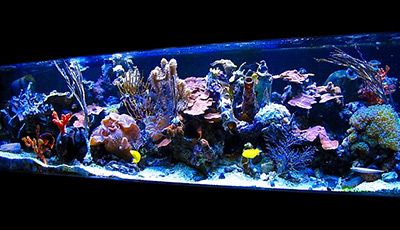Many marine fish can survive in captivity for decades, and many corals and other sessile invertebrates can hang in there, well, who knows how long. In any case, maintaining a marine aquarium “for the long term” can mean an awfully long time. His current tank has been up and running with much of the same livestock since somewhere around the Second Battle of Bull Run (being a New Yorker, Paul presumably wouldn’t have called it Second Manassas).
My style of aquarium keeping also leans toward the long-term, so I thought I’d dedicate today’s post to what I consider the pros and cons of this approach (versus keeping specimens for relatively brief periods and frequently changing up your livestock) for those whose hobby experience doesn’t yet span decades:
Pros:
- You gain a new respect for the growth potential of specimens—and thus the benefits of spacious housing. For example, reading that fish species X can reach Y inches/centimeters in maximum length doesn’t compare to actually seeing the genuine article fully grown and swimming around in your tank alongside a bunch of other fully grown specimens. The same applies to the growth potential of coral colonies. Those little frags can end up consuming a heck of a lot of space in your tank when left to their own devices for years and years.
- Maintenance and husbandry become second nature. I would never say you can put a long-term aquarium on “autopilot” and abandon water testing, but it becomes such a known quantity over time and your livestock becomes so familiar that you eventually develop the ability to catch certain problems in their earliest stages simply by observing subtle changes in the behavior/demeanor of your animals and trusting what your senses are telling you.
- Many marine fish can outlive the family dog or cat, so despite the fact that you can’t really pet them, they tend to “grow on you” and become more pet-like the longer they’re in your care. I’ve had the same percula clownfish since my son was a baby (he’s a sophomore in college now), and I’m determined to provide a home for that little clown until the end of its natural lifespan.
- You’re putting minimal pressure on wild populations. Despite exciting advances in captive-breeding programs, most of the marine fish in the aquarium trade are still wild-collected. If your focus is keeping the same assortment of livestock for the long term, you probably aren’t buying new specimens on a regular basis.
- There’s just a certain sense of reward you get when you’re able to strike that balance of aquarium suitability and compatibility that allows you to keep a particular assemblage of fish and invertebrates together and thriving for many years.
Cons:
- When keeping the same group of animals for a long time, you can’t necessarily experiment with a variety of different species without setting up multiple tanks (This may lead directly to MSAS!), which may or may not be problematic depending on your living arrangements.
- There’s a risk that seeing the same fish and corals for many years will become monotonous, leading to “Boring Tank Syndrome” and possibly loss of interest in the hobby.
- In the rare instances that you do try to introduce a new specimen, the established group, having shared the same tank for a long time, formed a solid pecking order, and become accustomed to each other’s presence, may be particularly unwelcoming toward the newcomer.
What have I overlooked?
As always, I’m sure I’ve overlooked some salient points here. If any of you longtime salties can think of anything you’d like to add, please share it in the comment section below.



